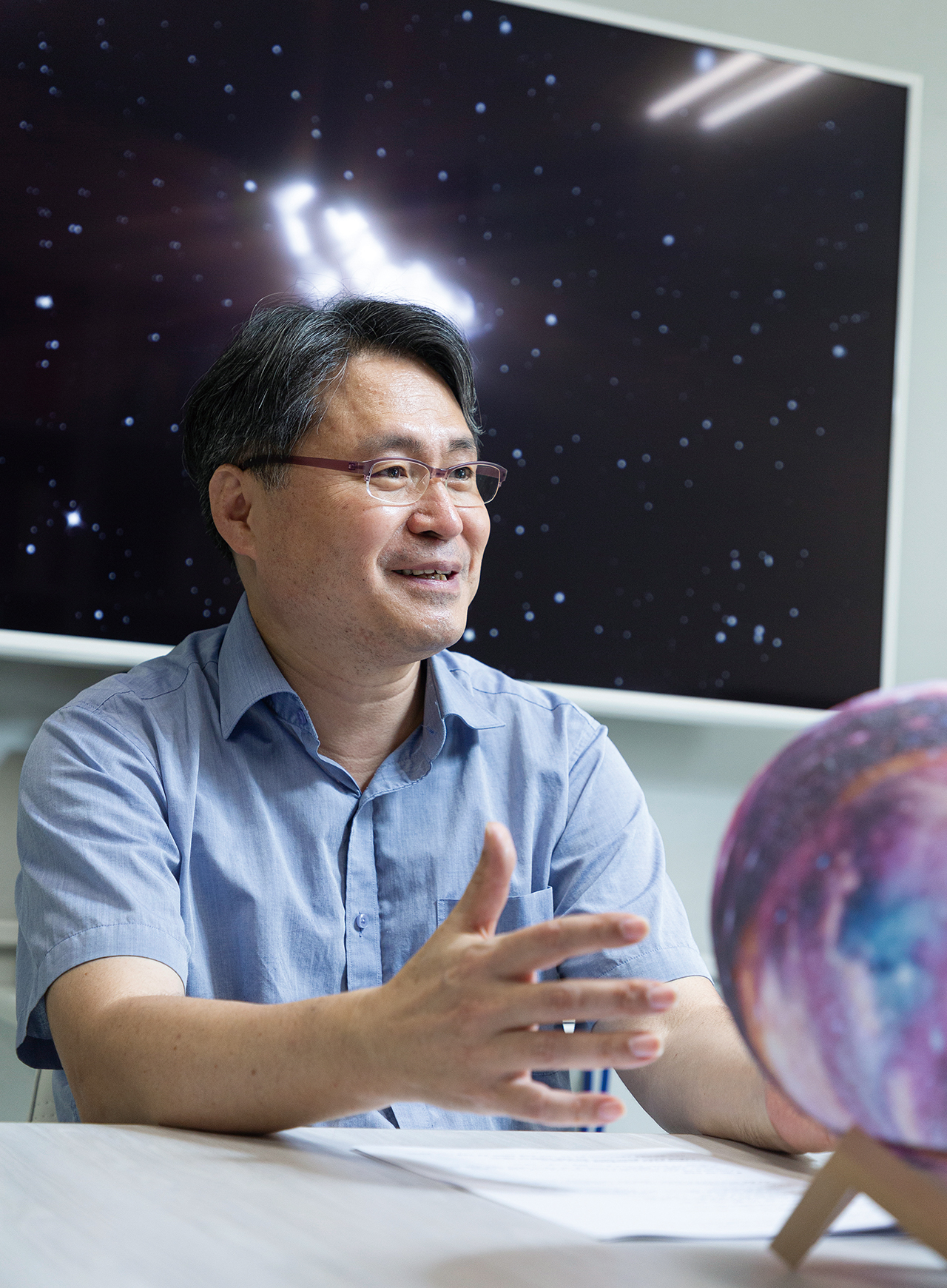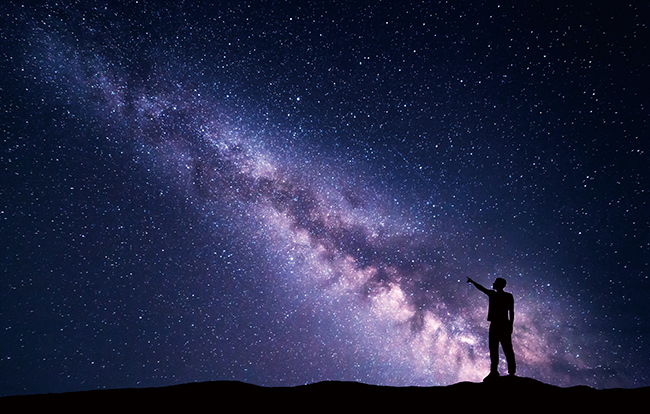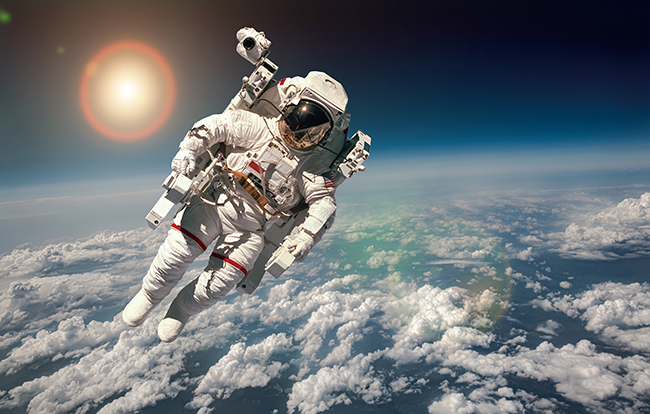Contents VOL. 259

COVER STORY
민간 우주관광이 시작되고, ‘누리호’가 쏘아 올려지는 2021년은 특별한 해로 기억될 것입니다. 인류의 미래 전략시장으로 자리 잡은 우주. <HYPER> 가을호에서는 민간 우주산업 본격화로 촉발된 ‘뉴 스페이스 시대’와 우리의 우주 전략에 대해 알아봅니다.

민간 우주관광이 시작되고, ‘누리호’가 쏘아 올려지는 2021년은 특별한 해로 기억될 것입니다. 인류의 미래 전략시장으로 자리 잡은 우주. <HYPER> 가을호에서는 민간 우주산업 본격화로 촉발된 ‘뉴 스페이스 시대’와 우리의 우주 전략에 대해 알아봅니다.
Scroll Down
Space exploration is not exclusive to scientists anymore. The general public can also go on space tours and create business items in space. It is an era where anyone can dream of space. We met Professor Kim Hang-bae, who researches cosmology, and heard about how humanity’s perspective on space has changed and how we should look at space in the New Space Era.

물리학과 김항배 교수
Professor Kim Hang-bae, Department of Physics
고대로부터 인류는 하늘을 바라보며 그 너머의 세상을 동경했다. 황홀경이 펼쳐지는 밤하늘을 올려다보고 있노라면 더욱더 탐구욕이 용솟음쳤다. 하지만 애석하게도 인간의 시력으로는 머리 위의 하늘은 물론, 그보다 더 광활한 우주를 가늠조차 할 수 없다. 그러니 코스모스(질서정연한 우주)의 신비를 열려면 협소한 인간의 시야에서부터 벗어나야 한다.
“우주를 눈으로 볼 수 있는 빛, 즉 가시광선으로만 보던 시대에서 벗어나 전파, 적외선, 자외선, 엑스선, 감마선 같은 다양한 전자기파의 파장 영역을 분석하기에 이르렀습니다. 그뿐만 아니라 중성미자, 중력파 등을 통해서도 우주의 새로운 모습들을 발견할 수 있죠. 우주는 다양한 방법으로 볼 수 있습니다. 마찬가지로 인간과 인간의 활동에 대한 관점도 다양해질 필요가 있다고 생각합니다.”
지난 5월 한양대학교 박물관이 개교 82주년을 기념해 마련한 ‘우주+人, 과학으로 풀고 예술로 빚다’라는 기획특별전에서 김항배 교수가 강연한 내용이다. 본 기획전은 우주의 기원을 찾는 과학자들의 연구와 우주를 주제로 삼은 예술가들의 작품을 한 데 선보인 점이 특징인데, 우주론과 입자천체물리학을 연구하는 김항배 교수는 ‘하늘을 보면 우주가 보인다’를 주제로 우주를 바라보는 다양한 방법을 소개했다.
“우주는 땅과 하늘을 포함해 우리가 살고 있는 시간과 공간을 포함하는 세상 전체를 이르는 말입니다. 우주론은 이 우주가 어떻게 생겼는지에 대한 이론이죠. 현대에 와서 과학과 관측 기술이 크게 진전하며 우주의 기원과 진화, 종말을 다루는 우주론이 과학의 한 분야로 자리 잡게 됐습니다.”
그런데 이 우주론은 시대에 따라 달라져 왔다. 인간이 세상을 바라보는 인식론이 변화함에 따라 우주에 대한 관점도 바뀌기 때문이다. 뱀과 거북, 코끼리가 지구를 받치고 있다고 생각한 고대 인도인의 우주론에서 현대의 빅뱅 우주론에 이르기까지, 우주론은 몇 차례의 도약을 거쳐 오늘날에 이르렀다. 김항배 교수는 우리나라 석학들과 현시대를 조망하는 네이버의 ‘열린연단’ 강연을 통해서도 방대한 우주론의 변천사를 일반인들도 알기 쉽게 정리해 전달한 바 있다.
“체계적으로 하늘을 관측한 첫 번째 문명인 수메르 문명은 별의 움직임을 보고 천구라는 개념을 고안했습니다. 천구 안에서 지구를 중심으로 해와 달, 5개의 행성이 회전한다고 생각했는데 이것이 동양과 서양 모두에 영향을 미쳤죠. 이를 정리한 기원후 2세기의 천동설이라 불리는 프톨레마이오스의 모형이 1500년 동안 이어져 오다가 16세기 코페르니쿠스 시대에 와서 태양 중심 모형의 근대 우주론이 제기됐습니다. 20세기 현대 우주론은 우리의 은하가 수많은 은하 중 하나이며, 우주는 팽창한다는 사실을 발견해냈지요.”
From ancient times, humans have looked up to the sky and admired the world beyond. While looking at the enchanting night sky, the desire for exploration grew more and more. Unfortunately, we cannot guess the vastness of space nor even the sky above our heads with our visions. So, to unravel the mysteries of the Cosmos (a well-ordered universe), we need to get out of our limited sights.
“We are no longer in the era of watching space using light visible to a naked eye. We can now analyze diverse electromagnetic waves such as radio waves, infrared light, X-rays, and gamma rays. We can also discover new aspects of space with neutrino and gravitational waves. You can observe space with diverse methods. Now, it is important to diversify the perspectives of looking at humans and human activities as well.”
The above is part of the lecture by Professor Kim Hang-bae in the special exhibition “The Cosmonaut” held in the Hanyang University Museum in May, celebrating the 82nd anniversary of its establishment. The exhibit focused on showing research by scientists who try to figure out the origin of space and artistic works with the theme of space. In the event, Professor Kim Hang-bae introduced different ways to observe space with the topic of “Space is seen when looking at the sky.”
“Space refers to the entire world, including the land, sky, time, and space we live in. Cosmology is a theory on how this space looks like. It is the present era that science and observation technologies have been significantly developed, and cosmology, which deals with the origin, evolution, and end of space, has become one of the fields of science.”
However, cosmology has changed over time because the view on space changes with the epistemology of humans perceiving the world. From ancient Indian cosmology where the world was on top of snakes, turtles, and elephants to the big bang theory, cosmology took many leaps. Professor Kim delivered the history of the universe in easy terms with other scholars through Naver’s “Open Lectures,” a series exploring the present era.
“The Sumerians were the first to observe the sky systematically and invent the concept of the celestial sphere after watching the movement of stars. They thought that the Sun, Moon, and five stars revolved around the Earth, and such belief influenced both East and West. The Ptolemy’s geocentric model in the 2nd century A.D. persisted for 1500 years, and it was in the 16th century, the Copernicus era, that the modern cosmology of heliocentrism was proposed. Modern cosmology in the 20th century suggests that the Galaxy is one of the numerous galaxies, and that the universe expands.”
현대 과학은 20세기 초 몇몇 과학적 발견에 의해 우주가 팽창한다는 사실을 밝혀냈다. 이는 우주가 변화한다는 의미이며, 그 말은 곧 우주에도 탄생이 있었다는 뜻이다. 이를 빅뱅이라 한다. 변함없이 그 모습 그대로 영원한 것이라 믿었던 우주에 기원이 있었다니, 이는 우주에 대한 인식에 획기적인 전환을 일으켰다. ‘우주는 왜, 그리고 어떻게 탄생한 것일까’라는 질문이 뒤따르지 않을 수 없다.
“과학계는 또다시 난제에 봉착했습니다. 차라리 기존의 영원불변 우주를 되살리려는 움직임(정상 우주론)도 있었죠. 사실 빅뱅 그 자체, 즉 무한대의 밀도와 온도를 가진 물질 상태가 왜, 어떻게 시작되었는지는 현재 우주론에서도 아직 밝히지 못한 부분입니다.”
인류는 이러한 과제를 부여받은 채 달을 넘어 화성, 목성, 명왕성에 이르기까지 우주에 대한 탐사를 멈추지 않았다. 그리고 뉴 스페이스 시대가 열린다는 소식에 과학자뿐 아니라 일반인들의 관심도 높아지고 있다. 이를 방증하듯 천문 및 우주를 소재로 한 강의나 영상 콘텐츠들이 유튜브를 통해 확산되고 있다. 오는 10월 국내 기술로 개발된 한국형 발사체 ‘누리호’가 발사될 예정인데, 그 성공 여부에 따라 뉴 스페이스 시대에 대한 우리 국민들의 관심 역시 더욱 고조될 전망이다. 김항배 교수는 인류가 대기권 밖을 벗어나 우주로 나가려는 시도를 호모사피엔스가 아프리카 대륙 밖으로 이동했던 것과 15세기에 신대륙을 개척하고자 대항해 시대를 열었던 것에 비유했다.
“인류의 역사는 미지의 세계를 개척하는 역사였습니다. 다시 한번 그와 같은 일이 일어나는 것이라 생각합니다. 그런데 신대륙을 찾아 망망대해를 건너는 일은 목숨을 걸어야 하는 위험한 일이었습니다. 지구 밖으로 나간다는 일은 그보다 훨씬 더 어려운 일이죠. 하지만 그동안 인류가 축적해온 우주에 대한 지식과 기술의 발전 덕분에 달까지는 비교적 안전하게 다녀올 수 있게 됐습니다.”
In the early 20th century, modern science revealed that the universe was expanding, which means the universe changes, and it was born. This is the big bang theory. People believed that the universe was unchanging and eternal, but it had its origin. This discovery drastically changed people’s perception of the universe. And, of course, the question of “why and how the universe was created” was raised.
“The science world faces a new challenge. Some people even wanted to revive the previous ‘eternal universe’ theory. In fact, why and how the big bang, or the material state with infinite density and temperature, started still remains unsolved in the current era.”
With these challenges, humankind is exploring the universe, from the Moon to Mars, Saturn, and Neptune. Not only scientists but also the general public are increasingly interested in the opening of the New Space era—an increasing number of lectures and video content on astronomy or space is being posted on YouTube. In October, the Korean space launch vehicle “Nuri” will be launched, and its success is expected to attract more attention to the New Space era. Professor Kim said humanity’s efforts to go to space are similar to the Homo Sapiens’ moving out of the African continent and the opening of the sea exploration era in search of new lands in the 15th century.
“Human history has been the history of pioneering unknown worlds. I believe the same is happening again. Crossing the open sea for new territories was a dangerous voyage risking lives. Reaching out to space is much more difficult than that. However, we can now travel back and forth to the Moon rather safely thanks to the accumulated knowledge and technology developments.”


그럼에도 인간이 중력을 극복해 지구를 벗어난다는 것이 얼마나 대단한 일인지에 대해 생각하게 된다는 김항배 교수. 그렇다면 지구 환경에 생존하도록 최적화된 인간은 산소도, 대기도 없는 지구 밖 세계를 왜 그리 동경하는 것일까. 그리고 민간인도 우주인이 될 수 있는 뉴 스페이스 시대에서 진정한 우주인이 되기 위해 우리는 어떤 마인드를 가져야 할까.
“우주를 개척해야 하는 동기가 무엇인지 생각해야 합니다. 심안과 통찰력이 필요해요. 우주를 갈망하는 것은 우주를 이해하고자 하는 것이고, 이는 인간에 대한 이해에도 영향을 미칩니다. 인간이 우주를 궁금해하는 근본적인 이유도 우주의 시공간과 물질의 동역학 속에서 인간이 어떻게 탄생하게 되었고, 그것이 어떤 의미가 있는가를 찾는 것 아니겠습니까. 내가 왜 세상에 존재하는가에 대한 질문은 그렇게 우주에까지 연결됩니다.”
어떻게 보면 그동안의 우주론 역사는 세상의 중심이라 여겼던 인간이 거대한 우주 속에서 티끌 만큼 작은 존재라는 것을 깨닫게 되는 과정이었다. 하지만 그만큼 세상은 대륙을 넘어 전 지구로, 그리고 우주라는 무한대로 확장돼왔다는 것을 기억해야 한다. 인간이 생각과 꿈을 키워 도전하는 만큼 새로운 세상이, 가능성의 문이 열리는 것이다. 별에서 온 인류가 다시 별로 향하고 있다고 말한 칼 세이건(Carl Sagan)은 그의 책 ‘코스모스’에서 다음과 같이 말하며 우주적 시야를 갖기를 당부했다.
‘돌이켜보건대 인류는 별에서 태어났다. 그리고 잠시 지구라 불리는 세계에 몸을 담고 살고 있다. 그러나 이제 자신의 원초적 고향으로 돌아가고 싶어 감히 그 기나긴 여정의 첫발을 내딛고자 하는 것이다.’
According to Professor Kim, he keeps thinking about how amazing it is to overcome gravity and get out of the Earth. So, why do people optimized to survive on Earth admire the world outside it, where there is no oxygen or atmosphere? What mindsets should we have to become a true astronaut in the New Space era, when anyone can be an astronaut?
“We need to think about the motives for exploring space. We need the mind’s eyes and insights. Longing for space means we try to understand space, which also influences the understanding of humans. After all, the fundamental reason humans are curious about space is related to searching the origin of humanity in space and time of the universe and the dynamics of matter and its meaning. The question of why I exist in this world leads to the question of space.”
In some ways, the history of cosmology has been the process of humans— who once thought they were the center of the universe—finding out that they are merely tiny particles in enormous space. We must remember that the world has expanded from land to the Earth and the infinite universe. The new world and doors of possibility open when humans think, dream, and take challenges.
Carl Sagan, who said that we are made of star-stuff and heading for another, emphasized in his book Cosmos that we should have cosmic perspectives, saying: “Human beings, born ultimately of the stars and now for a while inhabiting a world called Earth, have begun their long voyage home.”
